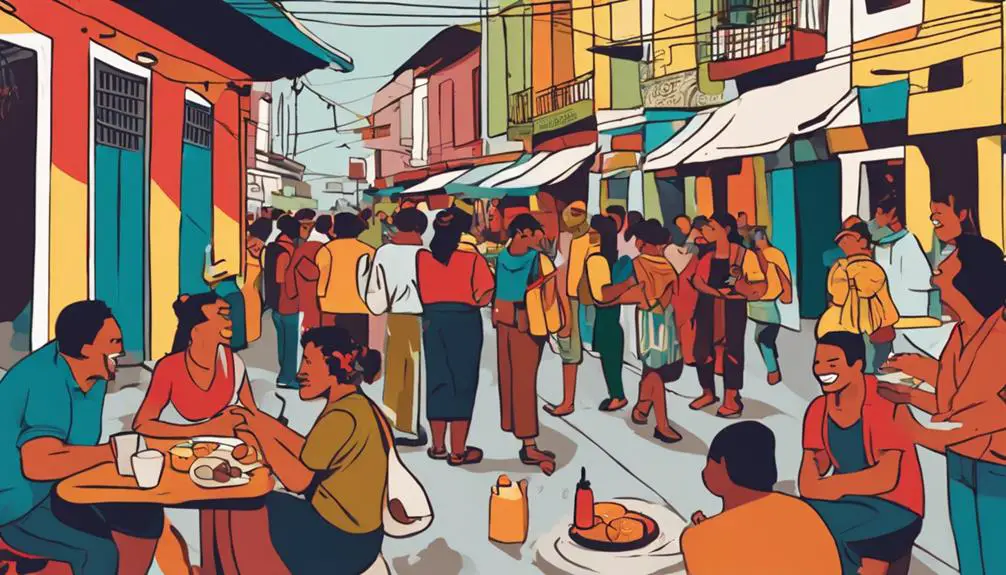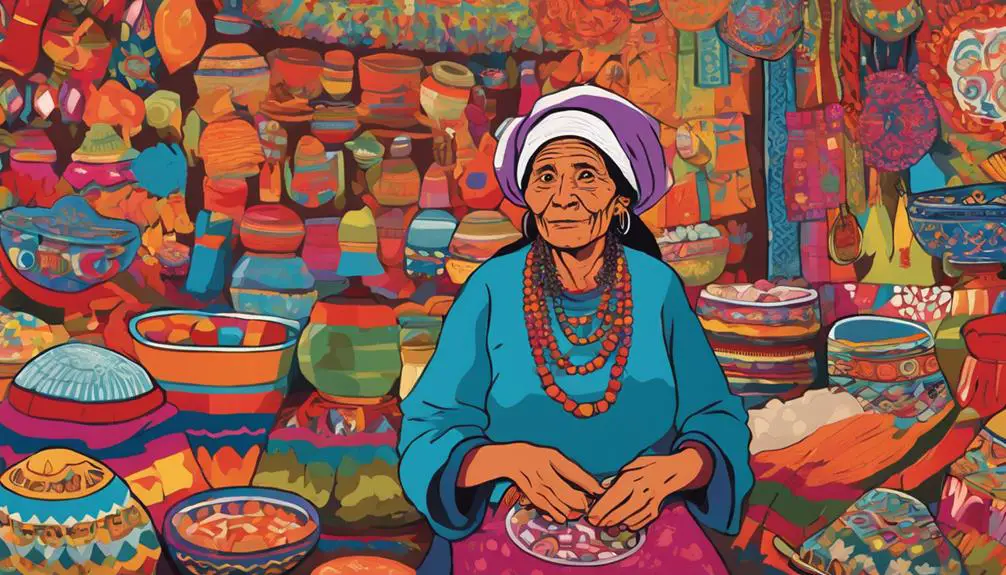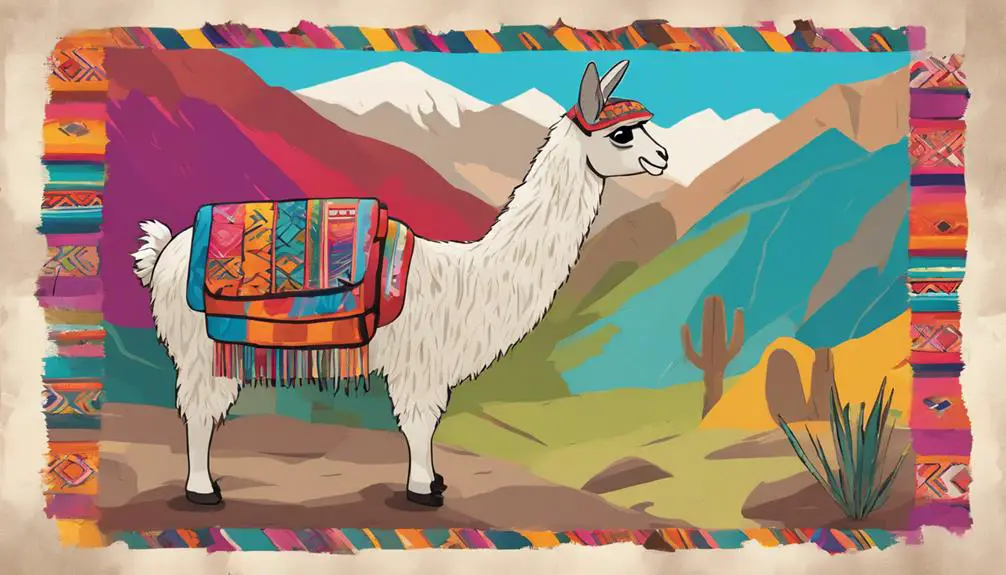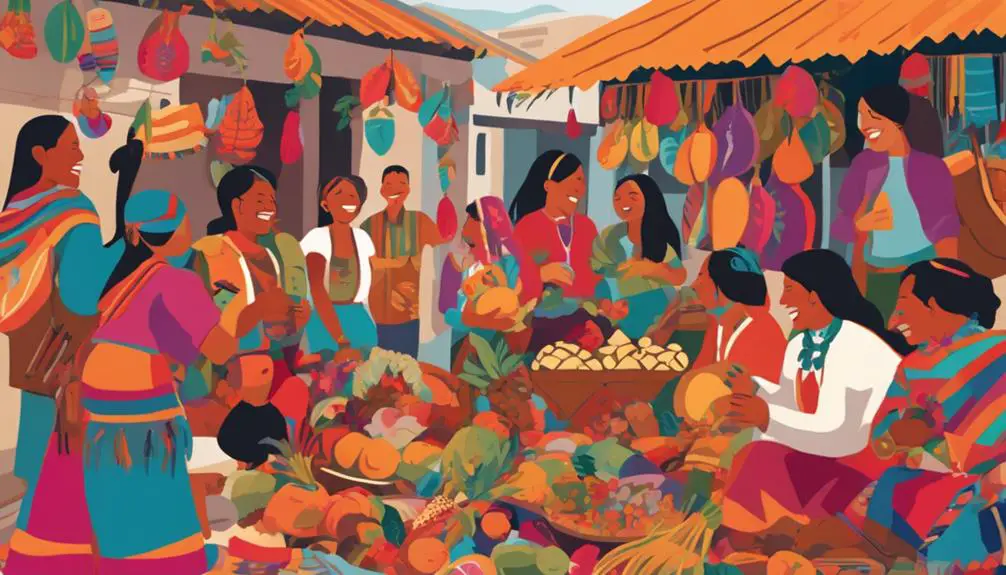As you explore Peruvian Spanish slang, you'll uncover a rich tapestry of cultural influences. Coastal dialects are laid-back, incorporating African and indigenous influences, while Andean variations show a stronger indigenous presence. Mastering slang nuances will shape your conversational flow and convey emotions and attitudes. Playful banter with locals will foster camaraderie and cultural immersion. Knowing slang for food and drink is essential, and mastering the Peruvian accent and pronunciation will refine your skills. The more you engage with Peruvian Spanish slang, the more you'll discover its complexities and intricacies, and the deeper you'll connect with this vibrant culture.
History Behind Peruvian Slang

As you investigate the vibrant cultural landscape of Peru, you'll discover that the country's slang has evolved from a complex interplay of indigenous, African, and European influences. The African influences, brought by enslaved Africans during the colonial era, infused the language with unique rhythms and cadences.
Meanwhile, Spanish colonization introduced Latin American idioms, which merged with the indigenous Quechua language, spoken by the Inca Empire. This cultural fusion resulted in a distinct Peruvian Spanish dialect, characterized by a blend of African, European, and indigenous linguistic features.
The African influences are particularly evident in the coastal regions, where African slaves were brought to work in plantations and mines. African rhythms and musical patterns permeated the language, giving it a distinct flavor.
In contrast, the Andean regions retained stronger indigenous influences, with Quechua phrases and idioms incorporated into everyday speech. This complex cultural heritage has shaped Peruvian slang, making it a unique and fascinating linguistic phenomenon.
As you explore further into Peruvian culture, you'll uncover the rich historical context that has given rise to this vibrant, dynamic language.
Regional Slang Differences
Across Peru's diverse regions, you'll encounter distinct slang variations that reflect the local cultural fabric, with the coastal, Andean, and Amazonian regions each boasting their unique flavor of Peruvian Spanish.
As you navigate the country, you'll notice that coastal dialects tend to be more laid-back and relaxed, often incorporating African and indigenous influences. The Andean variations, on the other hand, are marked by a stronger indigenous presence, with Quechua and Aymara languages blending with Spanish to create a distinct linguistic identity.
In the coastal regions, you'll hear phrases like 'chibolo' (dude) and 'papi' (buddy), which are deeply ingrained in the local slang. In contrast, the Andean regions have adopted words like 'wawa' (brother) and 'ch'aska' (beautiful), reflecting the rich cultural heritage of the indigenous communities.
These regional differences not only add flavor to Peruvian Spanish but also provide a window into the country's complex cultural tapestry. By understanding these variations, you'll gain a deeper appreciation for the nuances of Peruvian Spanish and the diverse communities that speak it.
Slang in Everyday Conversations

When engaging in everyday conversations in Peru, you'll frequently encounter slang that adds flavor and authenticity to interactions with locals.
As you navigate these conversations, you'll notice that slang nuances play a significant role in shaping the conversational flow. Locals often use slang to convey emotions, attitudes, and even humor, which can make interactions more engaging and relatable.
For instance, you might hear someone say '¿Qué onda?' (what's up?) or '¡Hagámoslo!' (let's do it!) to initiate a conversation or express enthusiasm.
These phrases may seem simple, but they're essential in establishing a connection with locals and immersing yourself in the culture. By incorporating slang into your conversations, you'll not only sound more natural but also demonstrate your willingness to adapt to the local way of communicating.
As you master the art of using slang in everyday conversations, you'll find that it enhances your interactions, fostering a sense of camaraderie and making your experiences in Peru even more unforgettable.
Peruvian Insults and Teasing
You'll soon discover that beneath the warm and welcoming exterior of Peruvian Spanish lies a rich tapestry of playful jabs and witty comebacks, where locals frequently engage in lighthearted insults and teasing, known as 'piropos,' to build camaraderie and strengthen social bonds.
This playful banter is an integral part of Peruvian culture, allowing individuals to develop close relationships and establish trust. When engaging with locals, you'll likely encounter these playful jabs, which can range from good-natured teasing to clever put-downs. Don't be taken aback – it's all part of the Peruvian charm.
Instead, learn to respond with clever banter responses, and you'll find yourself effortlessly handling social situations. Remember, the key to mastering Peruvian insults and teasing lies in understanding the nuances of language and cultural context.
Slang for Food and Drink
In Peru, where food is an integral part of the cultural fabric, mastering slang for food and drink is essential to maneuvering everyday conversations and culinary experiences. You'll find that Peruvians love to chat about food, and having the right vocabulary will make you a part of the conversation.
When it comes to street food, you'll hear the term 'comida callejera' thrown around. This refers to the delicious, affordable eats you can find on nearly every street corner, from anticuchos to picarones.
When it comes to drinks, you'll want to know about 'bebida fuerte,' which translates to 'strong drink.' This term is often used to describe a stiff cocktail or a shot of pisco. If someone asks you if you want a 'bebida fuerte,' be prepared for a potent drink that'll put some hair on your chest.
Expressions for Emotions and Feelings
Mastering Peruvian Spanish slang for emotions and feelings allows you to finesse complex social interactions and emotional nuances, making you a more empathetic and perceptive conversationalist. You'll be able to articulate your emotional state with precision, conveying the subtleties of your emotional experience.
For instance, when you're feeling overwhelmed, you can express your emotional intensity by saying 'estoy que me voy' (I'm about to explode). This phrase captures the sense of being on the verge of emotional overload.
When you're feeling vulnerable, you can use phrases like 'me da cosa' (it gives me the creeps) or 'me da miedo' (it scares me) to convey your emotional state. These expressions allow you to communicate your emotional vulnerability, fostering deeper connections with others.
Peruvian Idioms and Proverbs

Delving into the rich cultural heritage of Peruvian Spanish, you'll uncover a treasure trove of idioms and proverbs that offer a glimpse into the country's history, values, and traditions. These idioms and proverbs hold significant cultural significance, providing insight into the daily lives and struggles of Peruvians. They're not just colorful expressions; they're vessels of daily wisdom, passed down through generations.
You'll find idioms like 'Tomar el pelo' (to take someone's hair), which means to tease or make fun of someone. Then there's 'Estar la mar de…' (to be the sea of…), an expression used to describe something in abundance.
Proverbs like 'El que espera, desespera' (he who waits, despairs) offer words of wisdom, cautioning against procrastination. These idioms and proverbs are woven into the fabric of Peruvian culture, reflecting the country's history, values, and traditions.
As you explore Peruvian Spanish, you'll discover that these expressions are more than just phrases – they're a gateway to understanding the country's essence. By embracing these idioms and proverbs, you'll gain a deeper appreciation for the cultural significance and daily wisdom they convey.
Slang for Social Status
As you explore Peruvian Spanish slang, you'll come across two dominant social hierarchies: 'chibolo' and 'provinciano,' each carrying distinct connotations of social status, geographic origin, and cultural identity. These labels not only reflect an individual's socioeconomic standing but also their regional affiliation and cultural background.
On one hand, 'chibolo' refers to a rich kid from Lima, typically hailing from an affluent family. This term often carries a negative connotation, implying a sense of entitlement and snobbery.
In contrast, 'provinciano' describes someone from the provinces, often with a more humble upbringing. This label can evoke a sense of authenticity and down-to-earthness.
Interestingly, 'pobreton' is another slang term that pops up in conversations. While it literally means 'poor kid,' it's often used to affectionately describe someone from a lower socioeconomic background. This term acknowledges the individual's humble beginnings while expressing empathy and solidarity.
Common Slang Phrases for Travelers

When exploring Peru's vibrant streets, you'll frequently encounter a unique blend of Spanish and indigenous influences, which is reflected in the colorful slang phrases that locals use to add flavor to their everyday conversations.
As a traveler, familiarizing yourself with common slang phrases will help you navigate everyday situations with ease.
At markets, you'll hear vendors using phrases like '¿Cuánto cuesta?' (how much does it cost?) or '¿Dónde está…?' (where is…?).
Don't be surprised if you're greeted with a friendly '¿Qué onda?' (what's up?) or '¿Cómo vas?' (how are you?).
When arriving at the airport, you might hear airport lingo like '¿Dónde está mi vuelo?' (where is my flight?) or '¿Cuánto cuesta el taxi?' (how much does the taxi cost?).
Mastering these phrases won't only help you communicate effectively but also show respect for the local culture.
Mastering Peruvian Accent and Pronunciation
You'll need to fine-tune your ear to the distinct rhythms and intonations of Peruvian Spanish, where the melodic cadence of the Andes blends with the vibrant energy of coastal cities.
To master the accent, focus on the unique vowel pronunciation, where 'e' and 'i' sounds are often pronounced more openly and with a subtle 'eh' quality. Pay attention to the relaxed pronunciation of consonants, particularly the 's' sound, which is often pronounced with a soft 'sh' or 'zh' sound.
For effective Pronunciation Practice, listen to native speakers and mimic their intonation patterns. Record yourself speaking and compare it to native speakers to identify areas for improvement.
Accent Tips include slowing down your speech to better articulate words and using music and videos to improve your ear for the rhythm and cadence of Peruvian Spanish. Practice speaking with native speakers, either in person or online, to get a feel for the natural flow and rhythm of the language.
Frequently Asked Questions
Is Peruvian Spanish Mutually Intelligible With European Spanish?
When you explore the mutual intelligibility of Peruvian Spanish with European Spanish, you'll find that dialect differences and accent barriers can create challenges.
Although both share a common Latin American and European Spanish root, distinct regional features and pronunciation variations can lead to misunderstandings.
You might struggle to grasp certain expressions or idioms, but overall, you'll still be able to comprehend the general meaning, especially in formal situations or written communication.
Are There Any Peruvian Slang Words Borrowed From Indigenous Languages?
As you explore the linguistic landscape, you'll discover that many Peruvian Spanish words have borrowed from indigenous languages, showcasing the profound Quechua influence.
The Andean roots of Peruvian culture are deeply embedded in its language, with words like 'wawa' (baby) and 'ch'aska' (dawn) being incorporated into everyday speech.
You'll find that this blending of languages has enriched the Peruvian dialect, reflecting the country's rich cultural heritage.
Can I Use Argentine Slang in Peru Without Being Misunderstood?
As you venture across Latin America, you'll find that cultural exchange knows no borders, but regional differences do matter.
You can't simply transplant Argentine slang to Peru without risking miscommunication. While both countries share a Spanish tongue, local nuances and idioms diverge.
Be cautious when borrowing phrases, as what's trendy in Buenos Aires might confuse in Lima.
Is Peruvian Spanish More Formal or Informal Than Other Dialects?
When you communicate in Spanish, you might wonder if the dialect you're using is more formal or informal compared to others.
Generally, Spanish dialects vary in formality across regions. You'll find that some dialects, like those in Spain, tend to be more formal, while others, like those in some Latin American countries, are more informal.
Do Peruvian Spanish Speakers Use Slang in Professional Settings?
You might think that using slang in professional settings is a no-go, but surprisingly, even in corporate environments, you'll often hear colloquial expressions mixed with corporate jargon.
However, when working with Peruvian Spanish speakers, you'll find they tend to maintain a formal language, adhering to business etiquette and a professional tone. This is because, in Peru, workplace norms dictate a more formal approach, especially in client-facing roles, where a polished image is essential.
Conclusion
As you explore the vibrant world of Peruvian Spanish slang, remember that 'when in Rome, do as the Romans do.' Immerse yourself in the local culture, and don't be afraid to throw around some 'chibolos' and 'papis.'
Mastering Peruvian slang won't only enhance your travel experience but also earn you respect from the locals. So, go ahead, practice your 'ceja' and 'chavo,' and get ready to 'tomar el pelo' like a true Peruvian.
With time and practice, you'll be 'mango' in no time!







